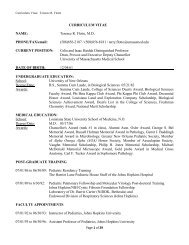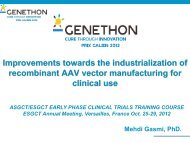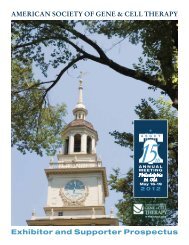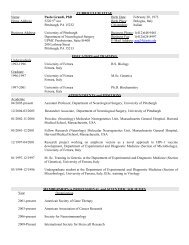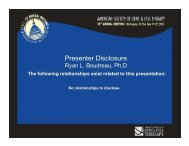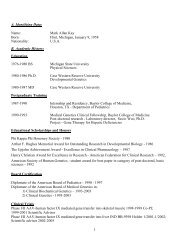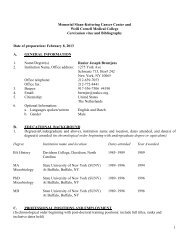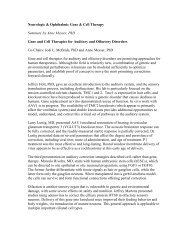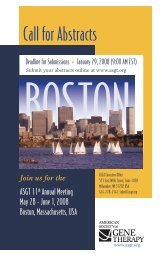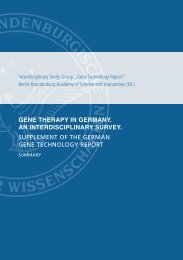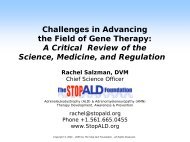FINAL PROGRAM - American Society of Gene & Cell Therapy
FINAL PROGRAM - American Society of Gene & Cell Therapy
FINAL PROGRAM - American Society of Gene & Cell Therapy
- No tags were found...
Create successful ePaper yourself
Turn your PDF publications into a flip-book with our unique Google optimized e-Paper software.
13 th AnnUAL MEETing | Washington, DC USA May 19-22, 2010 31Program ScheduleScientific Symposium 1121:00 pm - 3:00 pmRoom: Marriott Ballroom Salon 1Barriers to HSC <strong>Gene</strong> <strong>Therapy</strong>Co-ChairsManuel Grez, PhD & Harry L. Malech, MDSpeakersMary C. Dinauer, MD, PhDNew Approaches for Marrow Conditioning in HSC <strong>Gene</strong> <strong>Therapy</strong>In many genetic blood disorders, there is no selective advantage for hematopoietic stem cells following gene correction. Hence, in addition to expression <strong>of</strong> adequatelevels <strong>of</strong> the therapeutic protein, successful use <strong>of</strong> HSC gene therapy in these disorders will require efficient transduction, homing and engraftment <strong>of</strong> transduced HSC, aswell as cytoreduction <strong>of</strong> uncorrected HSC. It is highly desirable to develop effective conditioning regimens that reduce marrow content <strong>of</strong> uncorrected HSC yet minimizeexposure <strong>of</strong> patients to genotoxic agents and acute and long-term multiorgan toxicities. This talk will present new approaches for marrow conditioning for transplantationin HSC gene therapy, including more selective targeting <strong>of</strong> HSC in their niche.Luigi M. Naldini, MD, PhDExploiting and Antagonizing miRNA in <strong>Gene</strong> <strong>Therapy</strong>C. Anthony Blau, MDPharmacologically Regulated <strong>Cell</strong> <strong>Therapy</strong>Hematopoietic stem cells (HSC) compete for the opportunity to contribute to various mature cell lineages in the blood, however little is known about the rules that governthis competition. Eight years ago, two dogs were transplanted with autologous CD34+ cells that had been transduced with an gammaretrovirus vector encoding greenfluorescent protein (GFP) and a conditionally activatable derivative <strong>of</strong> the thrombopoietin receptor (F36VMpl). Responses to F36VMpl signaling, elicited through administration<strong>of</strong> a chemical inducer <strong>of</strong> dimerization (CID), were reported previously. Now long-term monitoring shows no spontaneous rises in GFP+ cells over time, suggestingthat F36VMpl is inert in the absence <strong>of</strong> CID. Stably higher frequencies <strong>of</strong> GFP+ B and T cells relative to other lineages suggests that CID administration within the first 18months post-transplantation generates stable increases in transduced lymphocytes, whereas only myeloid lineages responded when later courses <strong>of</strong> CID were administeredin one animal. Clonal tracking identified functionally distinct categories <strong>of</strong> hematopoietic stem cells: those that persisted and remained CID responsive, those that persistedbut were CID unresponsive, and those that did not persist.Christopher Baum, MDApproaches to Avoid Adverse Events in the <strong>Gene</strong>tic Modification <strong>of</strong> Hematopoietic <strong>Cell</strong>sAdverse events related to insertional mutagenesis or ectopic transgene expression may compromise the therapeutic prospects <strong>of</strong> gene therapy in the hematopoietic system.Over the past years, major progress has been made in the understanding <strong>of</strong> the underlying mechanisms, opening rational approaches to increase the therapeutic index. Wehave established sensitive nonclinical models, in transplanted C57BL/6J mice or using cultured cells, to reveal the transforming capacity <strong>of</strong> insertional activation <strong>of</strong> cellularproto-oncogenes such as Evi1 or Prdm16, and developed integrating gene vectors designed to reduce the risk <strong>of</strong> insertional transformation by altering the insertion patternand the expression cassette <strong>of</strong> the transgene. In a murine model <strong>of</strong> Mpl deficiency, major adverse events related to ectopic protein expression could be controlled bytranscriptionally targeted vectors. Two important principles emerge to ensure undisturbed long-term hematopoiesis from gene-modified cells. The first is the establishment<strong>of</strong> polyclonal hematopoiesis using vectors with an untargeted integration pr<strong>of</strong>ile and “physiological” transgene cassettes. The second is the generation <strong>of</strong> clonally definedhematopoiesis derived from induced pluripotent cells with genetic modification in bona fide safe harbours.Wednesday, May 19 th



